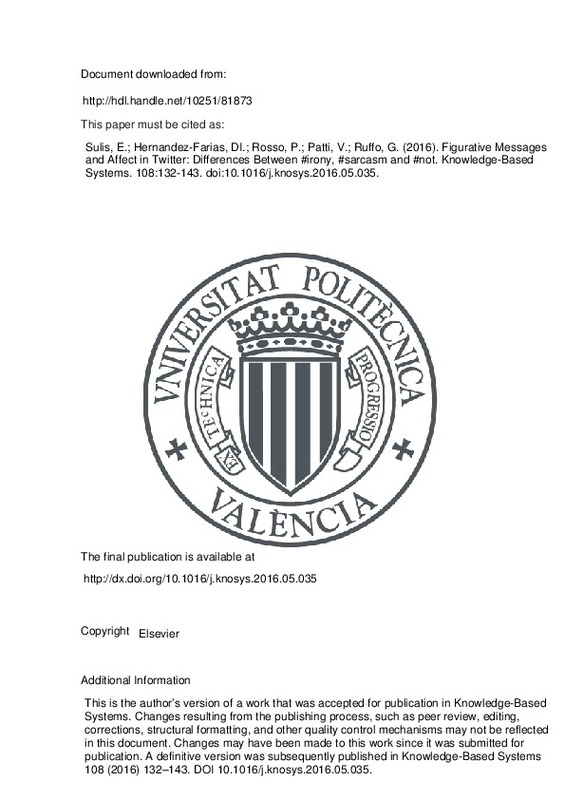JavaScript is disabled for your browser. Some features of this site may not work without it.
Buscar en RiuNet
Listar
Mi cuenta
Estadísticas
Ayuda RiuNet
Admin. UPV
Figurative Messages and Affect in Twitter: Differences Between #irony, #sarcasm and #not
Mostrar el registro sencillo del ítem
Ficheros en el ítem
| dc.contributor.author | Sulis, Emilio
|
es_ES |
| dc.contributor.author | Hernandez-Farias, Delia Irazu
|
es_ES |
| dc.contributor.author | Rosso, Paolo
|
es_ES |
| dc.contributor.author | Patti, Viviana
|
es_ES |
| dc.contributor.author | Ruffo, Giancarlo
|
es_ES |
| dc.date.accessioned | 2017-05-29T08:14:46Z | |
| dc.date.available | 2017-05-29T08:14:46Z | |
| dc.date.issued | 2016-09-15 | |
| dc.identifier.issn | 0950-7051 | |
| dc.identifier.uri | http://hdl.handle.net/10251/81873 | |
| dc.description | This is the author’s version of a work that was accepted for publication in Knowledge-Based Systems. Changes resulting from the publishing process, such as peer review, editing, corrections, structural formatting, and other quality control mechanisms may not be reflected in this document. Changes may have been made to this work since it was submitted for publication. A definitive version was subsequently published in Knowledge-Based Systems 108 (2016) 132–143. DOI 10.1016/j.knosys.2016.05.035. | es_ES |
| dc.description.abstract | The use of irony and sarcasm has been proven to be a pervasive phenomenon in social media posing a challenge to sentiment analysis systems. Such devices, in fact, can influence and twist the polarity of an utterance in different ways. A new dataset of over 10,000 tweets including a high variety of figurative language types, manually annotated with sentiment scores, has been released in the context of the task 11 of SemEval-2015. In this paper, we propose an analysis of the tweets in the dataset to investigate the open research issue of how separated figurative linguistic phenomena irony and sarcasm are, with a special focus on the role of features related to the multi-faceted affective information expressed in such texts. We considered for our analysis tweets tagged with #irony and #sarcasm, and also the tag #not, which has not been studied in depth before. A distribution and correlation analysis over a set of features, including a wide variety of psycholinguistic and emotional features, suggests arguments for the separation between irony and sarcasm. The outcome is a novel set of sentiment, structural and psycholinguistic features evaluated in binary classification experiments. We report about classification experiments carried out on a previously used corpus for #irony vs #sarcasm. We outperform in terms of F-measure the stateof-the-art results on this dataset. Overall, our results confirm the difficulty of the task, but introduce new data-driven arguments for the separation between #irony and #sarcasm. Interestingly, #not emerges as a distinct phenomenon. © 2016 Elsevier B.V. All rights reserved. | es_ES |
| dc.description.sponsorship | The National Council for Science and Technology (CONACyT Mexico) has funded the research work of Delia Irazu Hernandez Farias (Grant No. 218109/313683 CVU-369616). Paolo Rosso has been partially funded by SomEMBED MINECO research project (TIN2015-71147-C2-1-P) and by the Generalitat Valenciana under the grant ALMAMATER (PrometeoII/2014/030). The work of Viviana Patti was partially carried out at the Universitat Politecnica de Valencia within the framework of a fellowship of the University of Turin co-funded by Fondazione CRT (WWS Program 2). | en_EN |
| dc.language | Inglés | es_ES |
| dc.publisher | Elsevier | es_ES |
| dc.relation.ispartof | Knowledge-Based Systems | es_ES |
| dc.rights | Reserva de todos los derechos | es_ES |
| dc.subject | Figurative language | es_ES |
| dc.subject | Affective knowledge | es_ES |
| dc.subject | Irony | es_ES |
| dc.subject | Sarcasm | es_ES |
| dc.subject | es_ES | |
| dc.subject.classification | LENGUAJES Y SISTEMAS INFORMATICOS | es_ES |
| dc.title | Figurative Messages and Affect in Twitter: Differences Between #irony, #sarcasm and #not | es_ES |
| dc.type | Artículo | es_ES |
| dc.identifier.doi | 10.1016/j.knosys.2016.05.035 | |
| dc.relation.projectID | info:eu-repo/grantAgreement/CONACYT//218109%2F313683 CVU-369616/ | es_ES |
| dc.relation.projectID | info:eu-repo/grantAgreement/MINECO//TIN2015-71147-C2-1-P/ES/COMPRENSION DEL LENGUAJE EN LOS MEDIOS DE COMUNICACION SOCIAL - REPRESENTANDO CONTEXTOS DE FORMA CONTINUA/ | es_ES |
| dc.relation.projectID | info:eu-repo/grantAgreement/GVA//PROMETEOII%2F2014%2F030/ | es_ES |
| dc.rights.accessRights | Abierto | es_ES |
| dc.contributor.affiliation | Universitat Politècnica de València. Escola Tècnica Superior d'Enginyeria Informàtica | es_ES |
| dc.description.bibliographicCitation | Sulis, E.; Hernandez-Farias, DI.; Rosso, P.; Patti, V.; Ruffo, G. (2016). Figurative Messages and Affect in Twitter: Differences Between #irony, #sarcasm and #not. Knowledge-Based Systems. 108:132-143. https://doi.org/10.1016/j.knosys.2016.05.035 | es_ES |
| dc.description.accrualMethod | S | es_ES |
| dc.relation.publisherversion | http://dx.doi.org/10.1016/j.knosys.2016.05.035 | es_ES |
| dc.description.upvformatpinicio | 132 | es_ES |
| dc.description.upvformatpfin | 143 | es_ES |
| dc.type.version | info:eu-repo/semantics/publishedVersion | es_ES |
| dc.description.volume | 108 | es_ES |
| dc.relation.senia | 326665 | es_ES |
| dc.contributor.funder | Ministerio de Economía y Competitividad | es_ES |
| dc.contributor.funder | Generalitat Valenciana | es_ES |
| dc.contributor.funder | Consejo Nacional de Ciencia y Tecnología, México | es_ES |







![[Cerrado]](/themes/UPV/images/candado.png)

